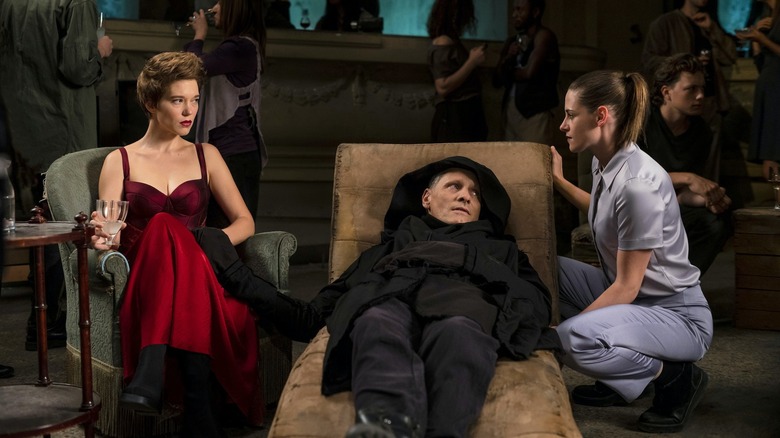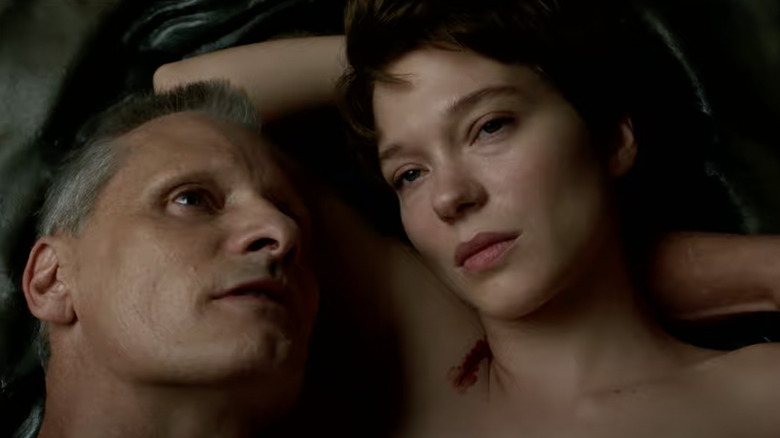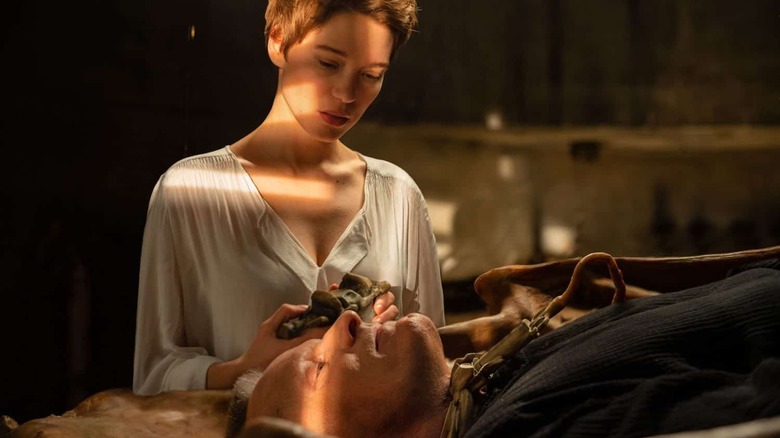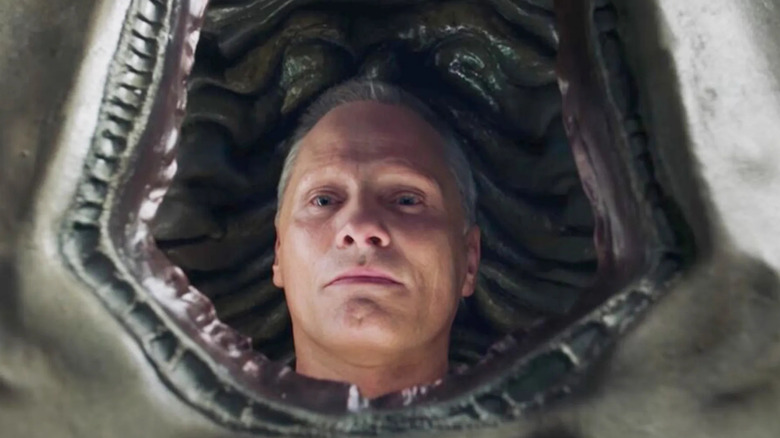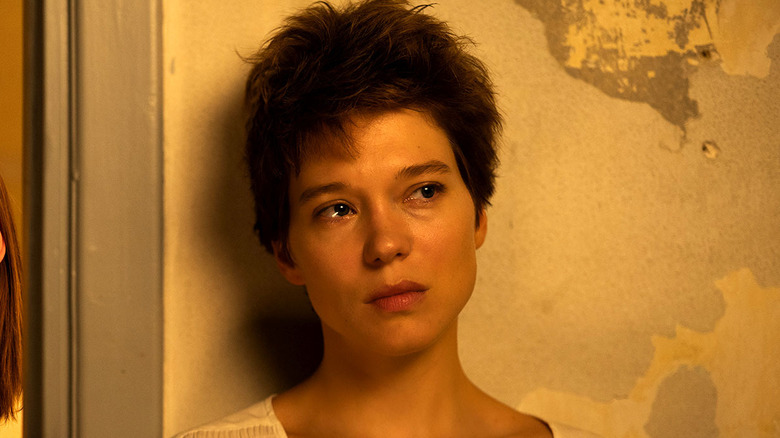Crimes Of The Future's Viggo Mortensen And Léa Seydoux On High Art And Creating A Relationship [Interview]
In David Cronenberg's "Crimes of the Future," Viggo Mortensen and Léa Seydoux play Saul Tenser and Caprice, a celebrity performance art duo in the near future. This is a future in which pain has been eliminated from the human body, and surgery has become the dominant fetish among the public. Because Saul's body has contracted the unusual biological habit of developing new, random, seemingly useless internal organs — it's called Accelerated Evolution Syndrome in the film — he and Caprice use an enormous, sophisticated mechanical sarcophagus to remove the organs in front of a paying crowd. This has become the most avant-garde artistic act in the future. Surgery has become the primary art, as well as the activity that is coming to replace sex.
"Crimes" is a heady, cerebral film that might serve as a playful criticism of the pretensions of the high art world, cloaked in classically Cronenbergian flesh-and-bone imagery. Tenser will ultimately find himself embroiled in a shadowy government conspiracy that links his unusual body to a strange coverup about a murdered child, the evolution of humankind, and the pervasiveness of pollution. It's Cronenberg's first science fiction film since 1999's "eXistenZ."
/Film was able to sit down briefly with Mortensen and Seydoux and talk about their views on high art and how the two of them developed their on-screen romance/working relationship.
'It's unusual, but it's very tender'
In "Crimes of the Future," you play high-profile artists who put on performance art pieces. You work in spaces where people are talking in highfalutin ways about the performances you're putting on and the importance of what you're doing in the art world. What sort of preparation did you do to understand performance art or the way art circles speak?
Mortensen: Well, it doesn't have to be just about performance artists. It is true, but it's just one small element of the story, really, that there is a send-up of pretentiousness and superficiality in some artists. You know, there's one very kind of a show stopper — visually — performance by a guy who has a myriad of ears that have been fused to his body. And it's very dramatic and all that, but there's not much underneath. But it's a send-up of art generally. It could be a send-up of movies that have shock value imagery and behavior or events in them, and then when you think about it after you've seen the movie, it's like, "Okay, well, that was a memorable or shocking image maybe, but what story is there underneath it? What's it about? Are they saying anything beyond, 'Oh, look at this?'"
And the artists in the film, who are not really as committed to art for art's sake and exposing themselves, literally and figuratively, in a sincere way, the way that Léa's character and mine do. There's a send-up of that. It's true that's there in a way.
I've seen some performance art, but it wasn't relevant. I was specifically paying attention to what we had to do or portray in the movie, and most of all, just to the relationship that I had to have with Léa. You know, for all the strangeness, visually, of this movie, at the heart of it, there's a really strong relationship. A love story, really. It's unusual, but it's very tender and it's really beautiful. So that's what I was paying attention to.
The relationship is more important than the art
Looking at your characters, I saw Elaine and Willem de Kooning, or Max Ernst and Dorothea Tanning, these famous art couples. I wonder if you did any art history study of those kinds of relationships, perhaps looking to them as a model for the romance and working relationship you had.
Seydoux: I didn't do anything ... no. But for me, it's the idea more than it's ... even though, when you are an artist, you need to be very first-degree. And you need to believe in what you do, and in a sense, you have to be very committed. But at the same time, even though you are committed to what you do, sometimes the meaning of things, it goes beyond what you see, if that makes sense.
So for me, when I thought about performance, it was not like, "Oh yeah, I have to relate to something very tangible." It's more the idea of what it is to be an artist. And it's the same for actors, but it can also be the same for writers or painters. You know, it's what it is to be an artist. And this is more about ... I didn't think about the ...
Mortensen: You thought more about the commitment.
Seydoux: Yeah. More about what it is to be an artist. And I think that, when you are an artist, it's true. There is this line in the movie that says, "We are creating meaning out of emptiness." And for me, it's a good definition of what it is to be an artist.
Mortensen: I mean, we weren't modeling it. It's not like we had discussions about artistic couples or performance artists. It wasn't really necessary. These are conceptual things that we can talk about now, but you can't act that.
The essential connection
Mortensen: It can be a reference. That's true. I mean, yes, I thought of transgressive artists like William Burroughs maybe a little bit at some point, but other than that, I didn't really delve into that or start re-watching performance art or something. What was really essential I thought was that we have a connection. That our connection personally, and our connection creatively, and the give-and-take. Not always agreeing, being insecure — in the case of my character, being competitive with other artists, [being] jealous, those are very human traits. And I think that it felt like you and I, Léa, we were looking for what was real about two people who have chosen to live and work together.
And we don't always agree! We don't always get along perfectly, but we sacrifice for each other, you know? The idea that, even though, as an artist, you have to be very selfish in some ways and determined and single-minded, but there are definite moments for each of us where we sacrifice our own personal, individual, creative ambitions for the physical and mental wellbeing of the other person.
Seydoux: And it's also, it works because we are a couple, in the sense that I am like the director and he's the actor. I mean, I work on his body and I need him to perform my art. And he needs me also to be direct, to be like a ...
Mortensen: To show.
Seydoux: To show and to ... Yeah.
Mortensen: To expose what I am, I think, yeah.
Seydoux: Yeah. What you are. Exactly.
An artist's insecurity
Mortensen: And there's a contradiction there. On the one hand, I'm kind of secretive and nervous, and I'm ill at ease in my own body. So I'm secretive and I cover it up and I stay home and am kind of reclusive and secretive about my physical state. And yet, our art involves exposing literally my innermost secrets in public performance and wanting to make our mark together in that way. And being jealous of other artists who are sort of maybe our competitors, but we don't think that they're as sincere or on the same level.
You know, that's a very common thing with artists sometimes. Even if they're very kind and generous, there's an insecurity there, too. Insecurity comes sometimes when you're being vulnerable and you're giving everything and showing everything.
"Crimes of the Future" is in theaters now.
